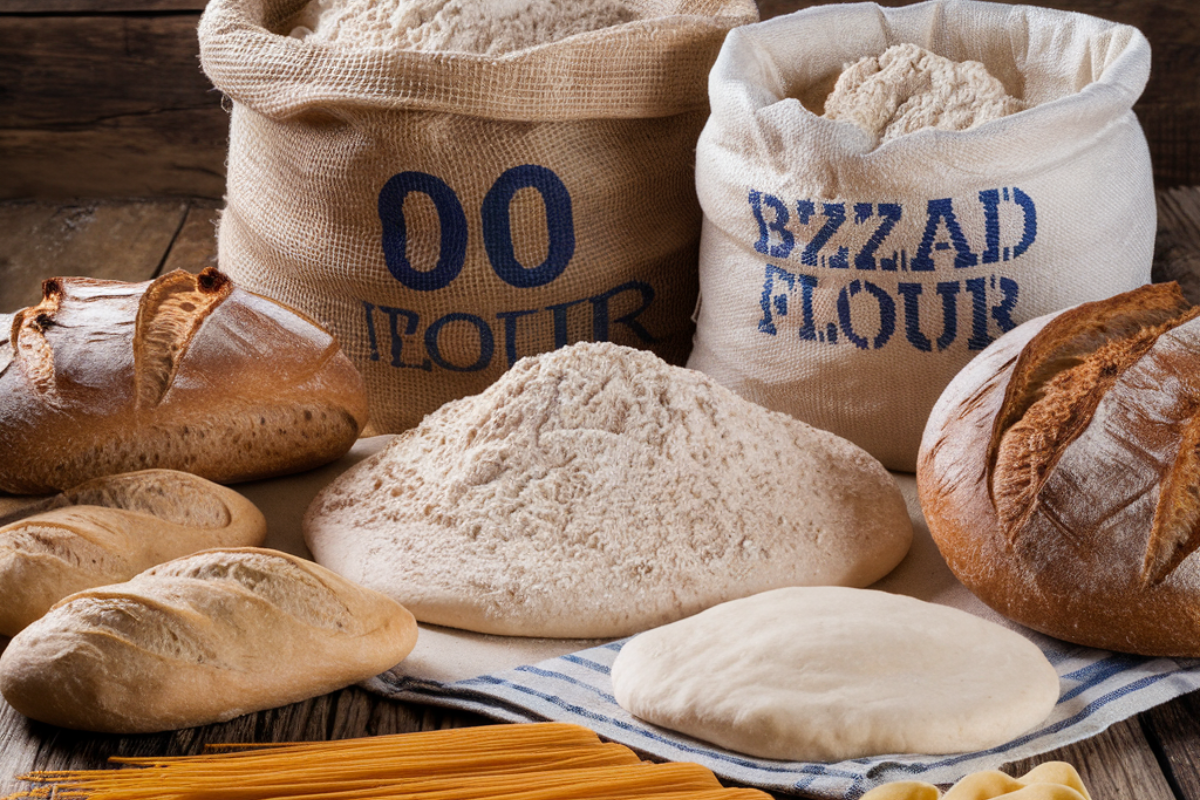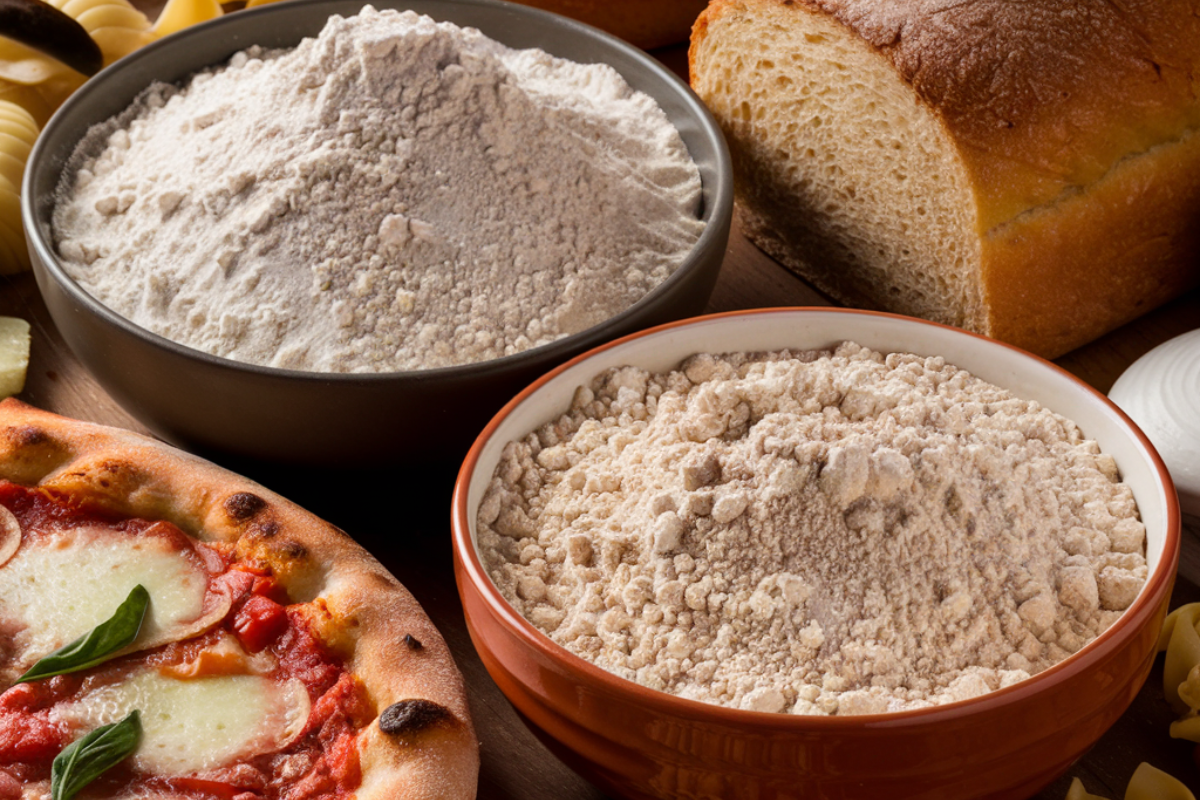Is 00 Flour the Same as Bread Flour?
When baking, you may come across different types of flour, and two that often raise questions are 00 flour and bread flour. Bakers frequently wonder whether these two flours can be used interchangeably. Although they share some similarities, their differences play a significant role in the texture, structure, and quality of the final product. Understanding these differences will help you make informed decisions in the kitchen, particularly when striving for specific textures and flavors in baked goods like bread, pizza, or pasta.
This article explores the characteristics, uses, and key differences between 00 flour and bread flour. We’ll take a closer look at how these flours perform in various recipes, what sets them apart, and why it’s crucial to choose the right one depending on what you’re baking.
What is 00 Flour?
Definition and Uses
00 flour is a finely milled Italian flour, celebrated for its smooth, powdery texture. The “00” in its name refers to the finest grind according to the Italian grading system. Bakers often prefer using this flour for recipes that require soft, elastic dough, such as traditional Italian pizza or fresh pasta.
This fine milling process is what makes 00 flour particularly suitable for these dishes. Because of its silky texture, it creates doughs that are easy to stretch and roll without tearing. For example, this Italian pizza recipe showcases 00 flour’s ability to create the perfect crust, offering a light, crispy exterior and a tender interior that melts in your mouth.
Protein Content in 00 Flour
A major distinction between 00 flour and bread flour lies in their protein content. Typically, 00 flour contains 7% to 12% protein, which is lower compared to bread flour. This reduced protein level leads to less gluten formation, making the dough more delicate and tender. As a result, it becomes easier to handle when shaping pizza dough or rolling out pasta sheets.
This feature is key to 00 flour’s role in making traditional Neapolitan pizza dough, which must be soft and flexible to achieve the right balance of a crispy outer crust and a tender interior. Lower gluten development allows the dough to stretch thinly without bouncing back while still maintaining its structure. As a result, the texture of pizza made with 00 flour is markedly different from chewier crusts made with alternative flour types.
Common Culinary Applications
Bakers often turn to 00 flour for various recipes:
- Pizza dough: ideal for Neapolitan-style pizzas with thin, crispy crusts that cook quickly in a hot oven.
- Fresh pasta: Its fine texture ensures smooth, elastic pasta dough that can be rolled out into delicate, silky pasta sheets.
- Flatbreads: Perfect for recipes requiring soft, tender doughs, such as focaccia or other Mediterranean-inspired bread.
Choosing the correct type of 00 flour is crucial. Higher-protein 00 flours (around 12%) provide more structure, making them better suited for pizza doughs that require strength and elasticity to hold toppings. For pasta, lower-protein versions yield a silkier result, creating a more delicate texture that enhances the overall dining experience.
For readers interested in more recipes, this comprehensive guide on using fine flour offers insights into crafting delicate pastries, savory pies, and thin-crust pizzas that are sure to impress.
What is Bread Flour?

Bread Flour Characteristics
Bread flour contains a higher protein content, typically ranging from 12% to 14%. This makes it ideal for recipes that require stronger gluten development, such as artisan bread and bagels. Gluten helps trap air bubbles, resulting in well-risen, chewy baked goods with a hearty texture.
Due to its higher gluten content, bread flour helps form a strong, stretchy dough that holds its shape and can withstand long fermentation times. This is particularly important when making rustic breads like sourdough, which need extended proofing to develop flavor. Sourdough made with bread flour typically has a chewy crumb and a complex flavor profile, ideal for anyone who enjoys the texture of homemade bread.
Gluten Development
The high protein content in bread flour leads to greater gluten formation, which strengthens the dough and contributes to its elasticity. This stronger gluten network helps the bread rise, hold its shape, and maintain a chewy texture. Bread flour’s gluten strength makes it perfect for sourdoughs, rustic breads, and other hearty baked goods that require a long fermentation period to fully develop their flavor and structure.
Common Baking Applications
Bread flour is commonly used for:
- Artisan breads: It provides a well-risen, hearty loaf with a chewy texture that’s ideal for sandwich bread or baguettes.
- Bagels: The high protein level creates the dense, chewy texture that bagels are famous for, ensuring that they have the perfect balance between firmness and chewiness.
- Thicker pizza crusts: Bread flour works well for pizzas that have a thicker, chewier base, perfect for those who prefer a dough with more substance.
For those looking to try making bread at home, this bread flour recipe (Bread Flour Recipe) offers an easy introduction to baking with high-gluten flour. Bread flour is also ideal for enriched doughs like brioche. The added strength from gluten helps these doughs maintain their structure despite the addition of rich ingredients like butter, sugar, and eggs. In recipes like brioche, where extra fat and sugar would normally hinder the rise, bread flour’s strong gluten network supports the dough beautifully.
Key Differences Between 00 Flour and Bread Flour
Protein Content
The primary difference between 00 flour and bread flour lies in their protein content. With higher protein levels, bread flour forms stronger gluten, which gives it a chewy structure perfect for bread and bagels. In contrast, 00 flour’s lower protein content results in softer doughs, ideal for pizzas and pastas that require less gluten and a more delicate texture.
Texture and Milling
00 flour is milled to a fine, powdery texture, which makes it great for delicate doughs that need to be soft and elastic. Bread flour has a coarser grind, which supports the stronger structure required for breads and other sturdy doughs. Both flours serve different purposes, depending on the type of baking you’re planning.
The fine texture of 00 flour makes it ideal for thin doughs, where you want a light, tender bite. In contrast, bread flour’s coarser texture gives baked goods more substance and chewiness, which works perfectly for robust, hearty recipes like chewy sourdough loaves.
Culinary Applications
While both flours can be used for pizza dough, they yield different results. 00 flour creates soft, elastic doughs that suit thin-crust pizzas. Bread flour, on the other hand, is better for thicker, chewier crusts. Some bakers even blend the two to achieve a balance between softness and structure in pizza crusts.
This guide on pizza crusts explores how different types of flour can impact the texture of your homemade pizzas, allowing you to customize the dough to your liking.
Can 00 Flour Be Substituted for Bread Flour?

In Bread Recipes
When it comes to bread recipes, substituting 00 flour for bread flour may affect the outcome. Bread flour’s higher gluten content helps the dough rise and hold its shape. Using 00 flour may result in a flatter, denser loaf due to its lower gluten development.
However, if you prefer a softer bread, you can substitute 00 flour for part of the bread flour in the recipe. The resulting bread will be slightly lighter, though not as chewy. Bakers seeking tender, sandwich-style bread may find this substitution ideal.
For those exploring sandwich bread options, this article on sourdough sandwich bread (Sourdough Sandwich Bread Recipe) highlights another great alternative with a softer crumb.
In Pizza Dough
Both flours can be used for pizza dough, but the results will differ. 00 flour creates a soft, elastic dough perfect for Italian-style pizzas. Bread flour makes thicker, chewier crusts, which are more common in American-style pizzas. You can also blend the two flours to balance chewiness and softness.
In Pasta Making
For pasta-making, 00 flour is the superior choice. Its fine texture and lower gluten content make for smooth, tender pasta dough. Bread flour, with its higher gluten, can result in a tougher, chewier pasta, which is less desirable. Therefore, it’s best to stick with 00 flour for pasta.
If you’re curious about pasta recipes, this guide on fresh pasta provides great techniques for working with 00 flour to make delicious, authentic pasta at home.
Nutritional Comparison Between 00 Flour and Bread Flour
Macronutrient Content
Both flours primarily provide carbohydrates. However, bread flour contains more protein, which can be beneficial if you’re looking to increase your protein intake in baked goods. Bread flour’s higher protein content makes it better for recipes requiring gluten strength, especially for those who prefer heartier breads.
Fiber Content
Whole grain bread flour contains more fiber than refined 00 flour, which typically has the bran and germ removed. This additional fiber in bread flour can contribute to better digestion and overall health. For those focused on dietary fiber, bread flour offers a more nutritious option.
Those interested in learning more about fiber-rich bread options can check out this article on cottage bread health benefits (Is Cottage Bread Healthy?) for healthier choices and comparisons between different bread types.
Vitamins and Minerals
Bread flour, particularly whole grain varieties, contains more vitamins and minerals than refined 00 flour. Whole grain bread flour retains the bran and germ, offering higher levels of B vitamins, iron, and magnesium. If you’re looking for flour with more nutritional value, whole grain bread flour is the better choice.
Conclusion
In conclusion, Is 00 flour the same as bread flour? No, they serve distinct purposes in baking. Bread flour’s higher protein content makes it ideal for chewy, structured doughs like bread and bagels. 00 flour, with its lower protein and fine milling, is better suited for soft, elastic doughs, such as pizza and pasta.
Understanding these differences helps you choose the right flour for your specific baking needs. Whether you’re aiming for a light pizza crust or a hearty loaf of bread, selecting the right flour ensures the perfect texture and flavor for your dish. Experimenting with blends of both flours can also unlock new textures and tastes, providing endless possibilities in the kitchen.
